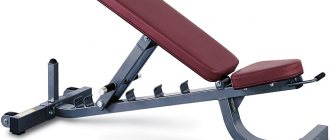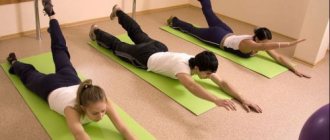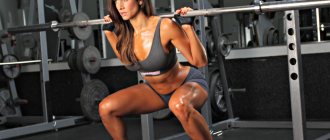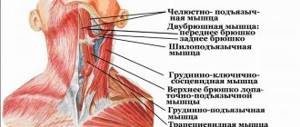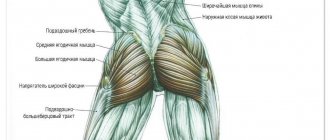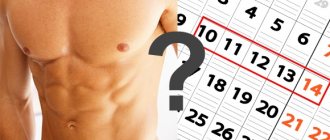Lower back muscles
Fat accumulates in the lower back because there are fewer muscles in this area
The muscles of the back, and especially the lower back, do not belong to the demonstration muscles - biceps, buttocks. Their weakening or shortening manifests itself in poor posture, specific pain, limitation of loads, and if these symptoms are ignored for a long time, it develops into the development of scoliosis, osteochondrosis and other diseases of the spine.
The load on the lower back is maximum: the weight of half the body, participation in all types of movement. The vertebrae of this section of the ridge are powerful and durable. At the same time, the lower back retains flexibility and the ability to rotate and bend movements. This is ensured not only by the joints of the spinal column, but also by the muscles.
Before pumping any muscle group, you should clarify what is included in it. The lumbosacral region includes the following muscles:
- The latissimus is the “visible” muscle. Men pay attention to it, since the latissimus forms a visually beautiful back.
- The muscles that straighten the spine are the spinalis, iliocostalis and others.
- Transverse spinous.
- Interspinous - deep muscles. These are short paired bundles that connect a pair of vertebrae.
- Intertransverse - short, connecting the transverse processes of a pair of vertebrae.
- Abdominal muscles - transverse and oblique, antagonists of the lumbar muscles.
- The quadratus lumborum muscle is the only muscle that connects the spinal column and legs. It is involved in all movements of the torso and in lifting the legs, as well as in supporting the body in a stationary position. When sitting for a long time, it works at an unfortunate angle and shortens under prolonged load. After which pain appears in all other positions, as well as when moving.
When choosing exercises for pumping muscles, it is worth keeping in mind one more thing – the piriformis. It connects the lower spine to the upper femur. Performs hip rotation and abduction. The piriformis works when walking and running, but with prolonged sitting it also contracts and spasms.
Exercise "Superman"
To begin, lie on your stomach with your arms extended in front of you and your palms on the floor. This is the starting position. Next, we simultaneously raise our arms and legs from the floor, trying to keep our abs and buttocks tense. In this case, you need to ensure that the neck is in line with the spine, for which you should look at your fingertips while working. With your arms and legs raised, you need to freeze for 1-2 seconds, after which you can lower them. This is 1 repetition.
Honey cake “Kaleidoscope”: a dessert that both children and adults like
A jeweler from India created a unique piece of jewelry with 12,638 diamonds.
Natural Leaders: People born in January have 10 special qualities
According to Fagan, "Superman" dynamically works the muscles of the lower back and promotes stretching. So if you feel the muscles moving in your lower back, then you are doing everything right.
Goals and objectives of home training
Pumping up the lower back muscles should be alternated with stretching
You can strengthen your lower back at home and in the gym. The purpose of the classes may also vary. If a muscle is hypertonic and causes pain, exercises are selected not so much for pumping as for stretching: it is important to lengthen the muscle fibers. If the lower back is weak, you need to train your back: first with your own body weight, then with weights.
If muscle tissue dystrophy has already caused changes in the spine - scoliosis, osteochondrosis, hernia - choose exercises to strengthen the lower back, but taking into account the disease. An example of such therapeutic gymnastics are complexes from Bubnovsky or Alexandra Bonina. You can study them from the video.
Training goals:
- Strengthening the core is required even for a completely healthy person if he works at a desk or if he leads a healthy lifestyle. You cannot effectively lift weights, barbells, or run with a weak lower back.
- Restoring or maintaining posture - weakening of the quadratus muscle leads to changes in lordosis and kyphosis. The spine is bent.
- Relief from pain – both weak and overstrained back muscles cause pain. Relaxation and lengthening relieve pain.
- Restoration of motor activity - when the core muscles become functional, a person regains the ability to move freely: run, dance, walk quickly.
- Aesthetic appearance - a smart posture and natural curves of the back represent a considerable amount of attractiveness.
The training is tailored to overall development. As recovery progresses, more and more complex power elements are included in the complex.
Lower Back Exercises – Deadlift
Bend forward and then straighten your torso while holding a heavy barbell in your hands - a truly basic exercise. It affects the maximum number of muscles in the human body. When combined with squats and weightlifting bench presses, the deadlift helps you gain good muscle mass.
The exercise is done using the lumbar erectors, adductor muscles of the hips, buttocks, lats, trapezius and forearms. It is performed with the heaviest weights.
Recommended number of repetitions in each working approach:
a) for accentuated work on the lower back – 10/12; b) for gaining total muscle mass – 6/8; c) for developing strength in pulling exercises – 3/5.
Effective exercises for women and men
The structure of muscles is the same in men and women. Therefore, they should work out their lower back in the same way in the gym or at home. Exercises are selected taking into account not gender and age, but goals: relaxation and stretching, pumping, treatment.
Complex for lengthening muscles
Abdominal pumping - twisting
The goal of the training program is to stretch the shortened muscle and relieve spasm. Yoga exercises are perfect for this purpose. Stretching is performed in different directions.
Before you take a static pose or begin movement, you need to create an initial stretch in the spine. For example, if an exercise is performed standing, at the beginning the athlete stretches his body up, perhaps raises his arms to enhance the sensation, and only then performs bends, twists, etc.
- Twisting – perform a gradual twisting from a standing position. First, lower the head with the chin to the chest, then twist the chest, bend, rounding the lower back and at the same time bending over, slightly bend the legs at the knees and lower the body until it assumes a free hanging position. They are also gradually rising. If the pain in the lower back is severe, when bending over, rest your hands on your legs to reduce the load.
- Cat - standing on all fours, round and straighten the back. The lower back follows the movement of the thoracic spine, and not vice versa. It's better to keep your head down. Exercise, when performed correctly, quickly relieves pain.
- The dog is a static yoga asana that stretches the quadratus and lumbar muscles, biceps and calves well. The pose requires some physical preparation.
- Half-bridge - lying on your back, place your feet as close to your buttocks as possible and lift your pelvis up, resting on your feet and shoulders. The distance between the buttocks and feet is determined by the degree of shortening of the psoas muscle. A flexible girl can start straight away from the bridge.
- The plank is reverse. In a sitting position with legs extended forward, rest your palms on the back of your body and lift your pelvis up, while simultaneously bending your knees. Keep the body level on your arms and bent legs for 30–60 s.
Lengthening exercises at the next stage of training are performed at the end of the session to relax strained muscles.
Strength exercises
Hyperextension on a fitball helps pump up the side muscles of the waist and back
It is somewhat more difficult to pump up the muscles of the lower back and back at home than in the gym. The core muscles are designed to support at least the weight of your body, and for training the load must be higher than usual.
- Seated corner - while sitting, bend your knees, lean back a little to maintain balance, raise and straighten both legs at your knees. Hold the corner for at least 10–15 seconds.
- Hyperextension - can be performed on a bench, floor, fitball. The amplitude in this case is limited, but the psoas muscle is partially pumped. You can make a “boat”.
- Hanging crunch – performed on any bar. In the starting position, raise straight or slightly bent legs, twisting in the back, and not using the abdominal muscles.
- Pull-ups - the option with weights is especially effective. But even trying to do the exercise bears fruit.
- Deadlifts are the best option for pumping up the lower back. At home, the barbell is replaced with dumbbells. It is extremely important to follow the technique here, so you need to study the exercise with a trainer.
The complex should include abdominal exercises. Antagonist muscles are just as important to support the lower back as your own.
To build muscle, you need to change your diet and include enough protein.
Lower back exercises – Hyperextensions
This exercise is recommended for beginner athletes and people with weak or previously injured backs. It targets the psoas, glutes and hip flexors. It is performed on a special simulator - a Roman chair.
If you don’t have this sports equipment, you can use a bench press and the help of a partner who will hold your legs in the thighs or shins. You can also perform this exercise on a gymnastic ball (fitness ball).
Technical nuances of performing the exercise on a Roman chair:
1. Lie down on a Roman chair with your stomach down, placing your heels under a bolster to support your feet.
2. Initial position: the body from heels to head is a straight line. The edge of the machine bench should be 5/10 cm below groin level. Arms crossed on chest.
3. Tilt (bend) the torso down 90º degrees relative to the legs.
4. Return (unbend) the torso to its original position. We linger in it for 1/1.5 seconds. You should not do excessive extensions in the lower back.
Adviсe:
- Eliminate the force of inertia in your movements.
- Perform full amplitude slow controlled flexion and extension.
- Do not round your back - this puts the load on your buttocks.
- Inhale as you go down and exhale as you go up.
Recommendations for organizing classes
It is recommended to perform the plank starting from 30 seconds
For the training to be beneficial, the following rules are observed:
- All relaxation exercises begin not from “zero”, but from a state of traction. When moving, keep your lower back straight.
- Strength exercises are done only after warming up. Stretching is performed after training.
- Stretch the muscles using no more than 30% of the maximum. The load in strength exercises is up to 50% of the maximum.
- Pain is not allowed. In case of acute pain, the training is stopped immediately; in case of ongoing pain, the exercise is replaced with a lighter version.
- Work out your muscles in a well-ventilated area. Clothes should be comfortable and light.
To ensure freedom of movement, even when it comes to walking, the load must be excessive compared to the everyday level. It is necessary not only to get rid of pain, but to make the muscles stronger in order to stabilize the spine.
Front bends with a barbell on the shoulders
This type of bending with weights works well for the lumbar erector spinae. When performing it, additionally, the leg muscles (hamstrings and buttocks) receive an excellent load. This exercise can be done sitting on a bench or standing.
For girls or those whose back muscles are not yet sufficiently developed, it is better to use the first option and perform bends with an empty bar.
Technical nuances of performing front bends with a barbell on the shoulders while standing:
1. Take the weight with a wide grip (from above), lift it above your head and place it on your trapezius.
2. Place your feet shoulder-width apart, straighten your back, slightly bending it in the lower back, bring your shoulder blades together and slightly bend your knees (if your legs are straightened all the way, then the largest part of the load will go to the hamstrings).
3. Slowly tilt the body forward and at the same time move the pelvis back.
The tilt of the torso should be done through the hip joint, and not through the lumbar spine.
4. Lower the body strictly until it is parallel to the floor and lift it back. At the same time, the pelvis should be pulled forward.
5. After passing the heaviest point of the climb (you will feel it), begin to take a deep breath.
6. Return to the starting position and, as you exhale, repeat the movement.
About strengthening the lumbar muscles
In this article I will depart from my usual style and write everything in the first person. I had a problem, one day I got osteochondrosis of the lower back while skiing. It hurt like hell, my nerves were pinched.
11 years have passed since then, today my working deadlift weight is 140 kg. Without any pharmacology, exclusively natural. And my back doesn't hurt. I'll tell you how to strengthen your lower back muscles so you never have problems with it. Even if you already have problems, I will help you stop their progression and relieve pain. So, let's begin.
Humans, unlike animals, experience a large number of problems with the spine. This is due to our upright posture and, accordingly, increased load on the spinal column. The lower back suffers for the same reason. The situation is aggravated by a sedentary lifestyle, weak muscles and the practice of lifting weights from the floor, when a person does this with a round back, bent in an “L” shape.
The psoas muscles provide softening or shock absorption of the compressive load on the spinal column. It is logical that strengthening the muscles of the lower back will allow them to better perform their function. The roots of the spinal cord, leaving the spine, will not be pinched (that is, there will be no lumbago in the back and no pain when bending over or walking).
And we will pump not only visible muscles that can be touched. There is also a psoas muscle that is not visible. The psoas muscle is considered a core muscle and flexes the hip, or the lumbar spine if the leg is fixed. When you arch your lower back, it certainly participates in this. A weak psoas muscle can be a cause of lower back pain.
We'll start with exercises for people who already have problems. Then we will look at exercises that can be performed after the initial strengthening of the back.

